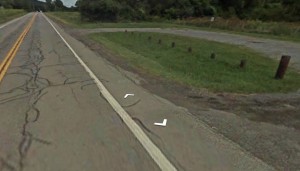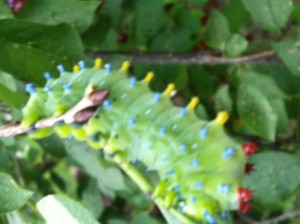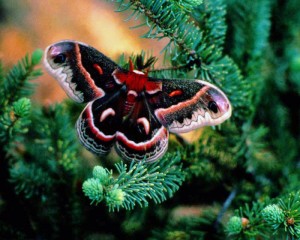A few weeks ago, we spent a week in Allegany State Park. Although it was June, many of the trees there looked more like December. If you spread a blanket under a tree that still had some leaves, trying to get some shade, before long, there would be a bunch of ugly, fuzzy caterpillars on it. Trunks and lower branches were riddled with last year’s egg masses.
Back in the 19th century, before the invention of synthetic fabrics, silk was a very popular clothing fabric. This material is made from the cocoon of a certain moth and there were many silk farms in the country. One producer from Massachusetts had the idea that if he could cross the silkworm with a certain silk producing moth from Europe, the result would be a moth that was more productive and disease resistant. So, he brought a few specimens over and reared them in a cage in his yard. One night, a strong wind knocked the cage over, some of the specimens escaped, and the gypsy moth was loose in the country. Having no natural enemies, it multiplied, extended its range every year, and now infests the northeast part of the country.
For the gypsy moth life cycle, go to www.fs.fed.us/ne/morgantown/4557/gmoth/cycle. Eggs hatch around May, when the leaves emerge. Massive populations of leaf eating caterpillars have been known to completely defoliate large trees by the end of June. Young caterpillars aften hang from trees by silk threads and are spread by the wind. Adults emerge in July after a short pupation, usually in bark crevices. White females don’t fly but remain attached where they emerged. Brown males fly around, looking for females. After mating, the female lays several hundred eggs in a white fuzzy mass.
Often, the white females can be seen on tree trunks, within reach. Killing those you can will benefit the forest. Eggs can be killed by scraping them into a jar of alcohol. Scraping them off the tree onto the ground does no good at all. The eggs are still alive and will hatch the following spring. If your travels take you to Allegany State Park, you will find many eggs you can kill, to help the park’s trees. Sometimes, females and egg masses have been found on the bottom of trailers. When the trailers are moved, moths are spread to a new area. Sprays that contain fungi or bacteria that kill the caterpillars have been used in heavily infested areas, with some success.
The spreading gypsy moths got some members of Congress thinking about legislation to regulate imports. The incident that got Congress to act occurred in 1910 when the Nation of Japan sent a friendship gift of flowering cherry saplings, to add some spring color to Washington. Along with the saplings was a little green and bronze beetle, the progeny of which you may have seen on your roses this year. Before the decade was up, Congress passed a Quarantine Act which gave the government authority to regulate all imports of meat, produce and all live plants and animals. The agency created to enforce this act, the Animal Plant Health Inspection Service, whose acronym sounds like a garden pest, provided this writer with gainful employment.
 We will hike the North tract and meet at the parking lot on SR64 1.4 miles North of the Bristol Mountain Ski area entrance, or 0.6 mile North of Lock Stock and Barrel. If coming from the North it is a little over three miles south of the Bristol town center which is at the intersection of SR64 and CR32. It’s easy to see, look for the DEC sign on the East side of the road. The parking lot is adequate but not overly large so park with that in mind. There is a Stid Hill South parking lot near the intersection with CR34 which is not where we will be, so don’t go there.
We will hike the North tract and meet at the parking lot on SR64 1.4 miles North of the Bristol Mountain Ski area entrance, or 0.6 mile North of Lock Stock and Barrel. If coming from the North it is a little over three miles south of the Bristol town center which is at the intersection of SR64 and CR32. It’s easy to see, look for the DEC sign on the East side of the road. The parking lot is adequate but not overly large so park with that in mind. There is a Stid Hill South parking lot near the intersection with CR34 which is not where we will be, so don’t go there. We will hike the North tract and meet at the parking lot on SR64 1.4 miles North of the Bristol Mountain Ski area entrance, or 0.6 mile North of Lock Stock and Barrel. If coming from the North it is a little over three miles south of the Bristol town center which is at the intersection of SR64 and CR32. It’s easy to see, look for the DEC sign on the East side of the road. The parking lot is adequate but not overly large so park with that in mind. There is a Stid Hill South parking lot near the intersection with CR34 which is not where we will be, so don’t go there.
We will hike the North tract and meet at the parking lot on SR64 1.4 miles North of the Bristol Mountain Ski area entrance, or 0.6 mile North of Lock Stock and Barrel. If coming from the North it is a little over three miles south of the Bristol town center which is at the intersection of SR64 and CR32. It’s easy to see, look for the DEC sign on the East side of the road. The parking lot is adequate but not overly large so park with that in mind. There is a Stid Hill South parking lot near the intersection with CR34 which is not where we will be, so don’t go there.

